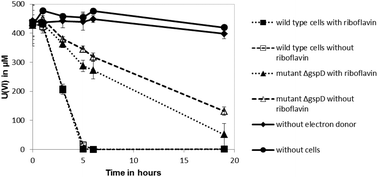Influence of riboflavin on the reduction of radionuclides by Shewanella oneidenis MR-1
Abstract
Uranium (as UO22+), technetium (as TcO4−) and neptunium (as NpO2+) are highly mobile radionuclides that can be reduced enzymatically by a range of anaerobic and facultatively anaerobic microorganisms, including Shewanella oneidensis MR-1, to poorly soluble species. The redox chemistry of Pu is more complicated, but the dominant oxidation state in most environments is highly insoluble Pu(IV), which can be reduced to Pu(III) which has a potentially increased solubility which could enhance migration of Pu in the environment. Recently it was shown that flavins (riboflavin and flavin mononucleotide (FMN)) secreted by Shewanella oneidensis MR-1 can act as electron shuttles, promoting anoxic growth coupled to the accelerated reduction of poorly-crystalline Fe(III) oxides. Here, we studied the role of riboflavin in mediating the reduction of radionuclides in cultures of Shewanella oneidensis MR-1. Our results demonstrate that the addition of 10 μM riboflavin enhances the reduction rate of Tc(VII) to Tc(IV), Pu(IV) to Pu(III) and to a lesser extent, Np(V) to Np(IV), but has no significant influence on the reduction rate of U(VI) by Shewanella oneidensis MR-1. Thus riboflavin can act as an extracellular electron shuttle to enhance rates of Tc(VII), Np(V) and Pu(IV) reduction, and may therefore play a role in controlling the oxidation state of key redox active actinides and fission products in natural and engineered environments. These results also suggest that the addition of riboflavin could be used to accelerate the bioremediation of radionuclide-contaminated environments.

- This article is part of the themed collection: Dalton Discussion 14: Advancing the chemistry of the f-elements

 Please wait while we load your content...
Please wait while we load your content...